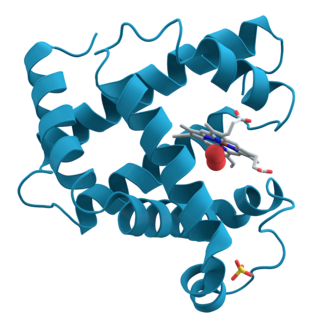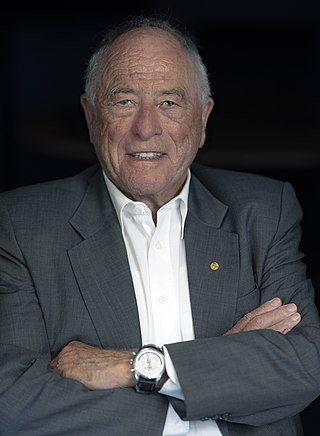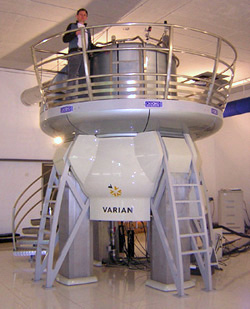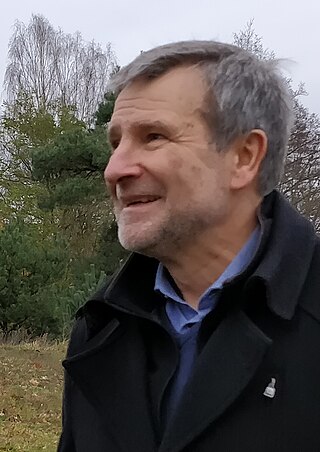
Structural biology is a field that is many centuries old which, as defined by the Journal of Structural Biology, deals with structural analysis of living material at every level of organization. Early structural biologists throughout the 19th and early 20th centuries were primarily only able to study structures to the limit of the naked eye's visual acuity and through magnifying glasses and light microscopes.
The Protein Data Bank (PDB) is a database for the three-dimensional structural data of large biological molecules, such as proteins and nucleic acids. The data, typically obtained by X-ray crystallography, NMR spectroscopy, or, increasingly, cryo-electron microscopy, and submitted by biologists and biochemists from around the world, are freely accessible on the Internet via the websites of its member organisations. The PDB is overseen by an organization called the Worldwide Protein Data Bank, wwPDB.

Kurt Wüthrich is a Swiss chemist/biophysicist and Nobel Chemistry laureate, known for developing nuclear magnetic resonance (NMR) methods for studying biological macromolecules.

Nuclear magnetic resonance spectroscopy, most commonly known as NMR spectroscopy or magnetic resonance spectroscopy (MRS), is a spectroscopic technique based on re-orientation of atomic nuclei with non-zero nuclear spins in an external magnetic field. This re-orientation occurs with absorption of electromagnetic radiation in the radio frequency region from roughly 4 to 900 MHz, which depends on the isotopic nature of the nucleus and increased proportionally to the strength of the external magnetic field. Notably, the resonance frequency of each NMR-active nucleus depends on its chemical environment. As a result, NMR spectra provide information about individual functional groups present in the sample, as well as about connections between nearby nuclei in the same molecule. As the NMR spectra are unique or highly characteristic to individual compounds and functional groups, NMR spectroscopy is one of the most important methods to identify molecular structures, particularly of organic compounds.
Nuclear magnetic resonance spectroscopy of proteins is a field of structural biology in which NMR spectroscopy is used to obtain information about the structure and dynamics of proteins, and also nucleic acids, and their complexes. The field was pioneered by Richard R. Ernst and Kurt Wüthrich at the ETH, and by Ad Bax, Marius Clore, Angela Gronenborn at the NIH, and Gerhard Wagner at Harvard University, among others. Structure determination by NMR spectroscopy usually consists of several phases, each using a separate set of highly specialized techniques. The sample is prepared, measurements are made, interpretive approaches are applied, and a structure is calculated and validated.
X-PLOR is a computer software package for computational structural biology originally developed by Axel T. Brunger at Yale University. It was first published in 1987 as an offshoot of CHARMM - a similar program that ran on supercomputers made by Cray Inc. It is used in the fields of X-ray crystallography and nuclear magnetic resonance spectroscopy of proteins (NMR) analysis.

WeNMR is a worldwide e-Infrastructure for NMR spectroscopy and structural biology. It is the largest virtual Organization in the life sciences and is supported by EGI.
The Bijvoet Centre for Biomolecular Research is a research institute at Utrecht University. The Bijvoet Centre performs research on the relation between the structure and function of biomolecules, including proteins and lipids, which play a role in biological processes such as regulation, interaction and recognition. The Bijvoet Centre houses advanced infrastructures for the analysis of proteins and other biomolecules using NMR, X-ray crystallography, electron microscopy and mass spectrometry. The institute is named after famous Dutch chemist Johannes Martin Bijvoet, who worked at Utrecht University.

Professor Ramakrishna Vijayacharya Hosur is an Indian biophysical scientist, known for his expertise in the areas of nuclear magnetic resonance and molecular biophysics. The Government of India honoured him, in 2014, by awarding him the Padma Shri, the fourth highest civilian award, for his contributions to the fields of science and technology.

G. Marius Clore MAE, FRSC, FRS is a British-born, American molecular biophysicist and structural biologist. He was born in London, U.K. and is a dual U.S./U.K. Citizen. He is a Member of the National Academy of Sciences, a Fellow of the Royal Society, a NIH Distinguished Investigator, and the Chief of the Molecular and Structural Biophysics Section in the Laboratory of Chemical Physics of the National Institute of Diabetes and Digestive and Kidney Diseases at the U.S. National Institutes of Health. He is known for his foundational work in three-dimensional protein and nucleic acid structure determination by biomolecular NMR spectroscopy, for advancing experimental approaches to the study of large macromolecules and their complexes by NMR, and for developing NMR-based methods to study rare conformational states in protein-nucleic acid and protein-protein recognition. Clore's discovery of previously undetectable, functionally significant, rare transient states of macromolecules has yielded fundamental new insights into the mechanisms of important biological processes, and in particular the significance of weak interactions and the mechanisms whereby the opposing constraints of speed and specificity are optimized. Further, Clore's work opens up a new era of pharmacology and drug design as it is now possible to target structures and conformations that have been heretofore unseen.
Dennis Torchia is an American biophysicist who specialized in NMR spectroscopy. He spent most of his career at the National Institute of Dental and Craniofacial Research (NIDCR), part of the United States National Institutes of Health, where he served as Chief of the Structural Biology Unit before his retirement in 2006.

David Lyndon Emsley FRSC is a British chemist specialising in solid-state nuclear magnetic resonance and a professor at EPFL. He was awarded the 2012 Grand Prix Charles-Leopold Mayer of the French Académie des Sciences and the 2015 Bourke Award of the Royal Society of Chemistry.
Marc Baldus is a physicist and professor of NMR spectroscopy at Utrecht University. He is especially known for his work in the field of structural biology using solid-state nuclear magnetic resonance (ssNMR) spectroscopy. He applies ssNMR methods to establish structure-function relationships in complex biomolecular systems including membrane and Amyloid proteins. In addition, he develops cellular NMR methods to study large molecular transport and insertion systems in bacteria as well as signal transduction mechanisms in eukaryotic cells.

Claudio Luchinat is an Italian chemist. He is author of about 550 publications in Bioinorganic Chemistry, NMR and Structural Biology, and of four books. According to Google scholar, his h-index is 90 and his papers have been quoted more than 33,000 times.

Hartmut Oschkinat is a German structural biologist and professor for chemistry at the Free University of Berlin. His research focuses on the study of biological systems with solid-state nuclear magnetic resonance.

Gerhard Wagner is a German-American physicist. Currently the Elkan Rogers Blout Professor of Biological Chemistry and Molecular Pharmacology at Harvard Medical School, he is an Elected Fellow of the American Association for the Advancement of Science, German National Academy of Sciences Leopoldina, American Academy of Arts and Sciences, National Academy of Sciences and International Society of Magnetic Resonance.
Alessio Ciulli is an Italian British biochemist. Currently, he is the Professor of Chemical & Structural Biology at the School of Life Sciences, University of Dundee, where he founded and directs Dundee' new Centre for Targeted Protein Degradation (CeTPD). He is also the scientific co-founder and advisor of Amphista Therapeutics.

Gaetano T. Montelione is an American biophysical chemist, Professor of Chemistry and Chemical Biology, and Constellation Endowed Chair in Structural Bioinformatics at Rensselaer Polytechnic Institute in Troy, NY.
CERM is a research facility at the University of Florence specialized in the application of NMR studies to biomolecules. It is a leading research center in Tuscany.
Ivano Bertini was an Italian chemist recognized for his significant contributions in the field of bioinorganic chemistry, particularly in NMR spectroscopy of metalloproteins.











